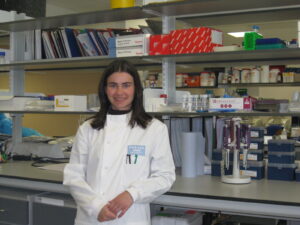My Reflections on the Field of Schwannomatosis since 2007
Miriam J Smith, PhD, The University of Manchester
Discover more articles in the Women in NF series by clicking here.
I began working in the field of schwannomatosis in 2007, just after Theo Hulsebos published the identification of pathogenic SMARCB1 variants as a cause of schwannoma predisposition. I joined Mia MacCollin and Scott Plotkin’s lab as a postdoc at MGH, just as Mia was about to leave Boston, and while Chelsea Boyd was screening their cohort of NF2-negative schwannomatosis families for SMARCB1 variants. We reported variants in 68% of their familial schwannomatosis cohort, including four families with the c.*82C>T variant, which is now known to be the most common recurrent pathogenic variant in SMARCB1-related schwannomatosis. At the time, delineating the different forms of schwannomatosis already seemed complicated due to the overlapping phenotypes between NF2– and SMARCB1-related schwannomatosis, as well as the knowledge that truncating pathogenic variants in SMARCB1 were already known to cause a predisposition to childhood rhabdoid tumours. I subsequently began characterising the effects of schwannomatosis-related SMARCB1 splice variants and the 3’untranslated region variant. I enjoyed my time at MGH, and Scott was a great mentor to me during that time, introducing me to several people working in the field.
 I look forward to the Children’s Tumor Foundation’s Annual NF meeting every year and I have met several new collaborators at the meeting over the years. The first meeting I went to was in Bonita Springs, Florida in 2008. Gareth Evans and Sue Huson were co-chairing the meeting and Vic Riccardi won the von Recklinghausen award. The award ceremony was an interesting and entertaining way to find out about the history of the field and the origins of the Children’s Tumor Foundation. Scott introduced me to Gareth at that meeting and when I returned to the UK in 2009, I joined Gareth’s lab in Manchester. I have been working on schwannomatosis in Manchester ever since. I am particularly interested in identifying and interpreting the molecular genetic causes of, and genotype-phenotype correlations between, different schwannoma and/or meningioma predisposition syndromes. Obtaining funding for these projects is always difficult, but in 2011 I received a Young Investigator Award from the Children’s Tumor Foundation (third time lucky!) and a project grant from the AICR (now worldwide cancer research) charity to search for novel causative genes. Through these studies, I identified pathogenic loss-of-function SMARCE1 variants as a cause of a novel, rare tumour predisposition disorder that causes clear cell meningiomas. Within a few weeks of the discovery, it had been translated to the clinical genetic testing lab in Manchester where they now offer sequencing of SMARCE1 as a national service within the NHS.
I look forward to the Children’s Tumor Foundation’s Annual NF meeting every year and I have met several new collaborators at the meeting over the years. The first meeting I went to was in Bonita Springs, Florida in 2008. Gareth Evans and Sue Huson were co-chairing the meeting and Vic Riccardi won the von Recklinghausen award. The award ceremony was an interesting and entertaining way to find out about the history of the field and the origins of the Children’s Tumor Foundation. Scott introduced me to Gareth at that meeting and when I returned to the UK in 2009, I joined Gareth’s lab in Manchester. I have been working on schwannomatosis in Manchester ever since. I am particularly interested in identifying and interpreting the molecular genetic causes of, and genotype-phenotype correlations between, different schwannoma and/or meningioma predisposition syndromes. Obtaining funding for these projects is always difficult, but in 2011 I received a Young Investigator Award from the Children’s Tumor Foundation (third time lucky!) and a project grant from the AICR (now worldwide cancer research) charity to search for novel causative genes. Through these studies, I identified pathogenic loss-of-function SMARCE1 variants as a cause of a novel, rare tumour predisposition disorder that causes clear cell meningiomas. Within a few weeks of the discovery, it had been translated to the clinical genetic testing lab in Manchester where they now offer sequencing of SMARCE1 as a national service within the NHS.
In 2013, I set up my own research lab in Manchester and continued to search for novel causative variants and important molecular mechanisms. When Arkadiusz Piotrowski et al discovered LZTR1 as a novel cause of schwannomas in 2014, we soon found many new variants in our own cohort in Manchester. I had already thought that the involvement of SMARCB1 variants in schwannomatosis was complicated, but LZTR1 variants have made things much more complicated. We found an association of LZTR1 variants with unilateral vestibular schwannoma (in about 5% of LZTR1-related schwannomatosis), which had previously been an exclusion criterion for non-NF2-related schwannomatosis. The variety of LZTR1 variants also seems more complicated, and there is an apparent overlap between variants found in schwannomatosis and Noonan syndrome.
I enjoy discovering and interpreting new variants, investigating the effects of variants of uncertain significance and collaborating with the clinical team to help provide genetic diagnoses. The publication of the ACMG guidelines for variant classification in 2015 and the multitude of updates on various aspects of their interpretation, which have been published since then, have so far made classification of schwannomatosis variants quite challenging. However, I was excited to become part of the variant curation expert panel for NF & schwannomatosis, which was set up in 2022. I enjoy working with the group and I look forward to continuing this collaboration in the future.

